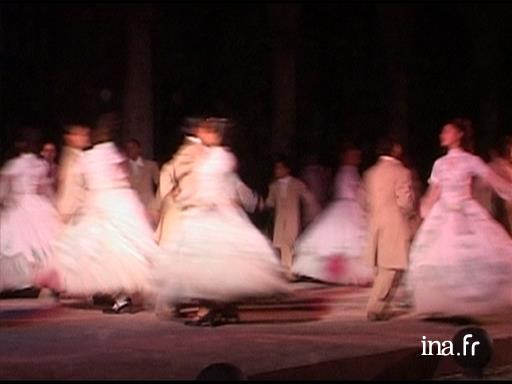
The travels of social dances
History of words
The men and women who came before us always loved to dance. As it is not our intention to produce a historic masterpiece, we shall not go back to the dawn of time, but only a few centuries, for example to the time of our dancing King: Louis XIV. The Académie de danse was created in 1661. So what did they dance back then? Minuets, pavans, “low dances", which were performed at Versailles slowly and affectedly wearing heavy and bulky costumes, while popular dances, including the rigaudon, were much lighter and already more “sport-like” to some extent. Many other dances followed before we had the waltz, which we shall discuss later, followed by the polka, quadrilles, tango, rumba, rock 'n' roll, and salsa...
This strand of dance had various names: Danses de salon, *Ballroom dances, couple dances, and some people mixed, as they do today, these dances with sport or competition dances, which are only an epiphenomenon, an old form of marathons. Today, our ballroom dances are more often called social dances for various reasons.
The term "Dances de salon" is no longer really appropriate: this terminology is too reminiscent of ballrooms and high-society dancers of the end of the 19th century. These dances were neither really couple dances, since they were also practised in groups, as were some traditional dances; or in groups of couples, like with quadrilles; and also in groups of individuals, like during the Madison dance. This is why the use of the term "social dances" makes perfect sense, for three specific reasons:
First, these dances were only practised at social gatherings: dancers were surrounded by an audience who would perhaps replace them for the next dance. We see the same phenomenon in public squares, as with balls held on the 14th July, or in private dance hall: everyone dances with everyone else, or almost, and the goal is to relax and enjoy a simple, physical, if not carnal, musical time: people coming together and socializing without the need to speak.
Secondly, all these dancing practices have the same purpose in common: TO SOCIALIZE, i.e. to create links between humans, whatever origin, nationality, social or cultural status they may be or have. In addition to sharing the same place, time and space, there are also certain expectations: a common conviviality, mutual friendship and respect, even when it is faked for the occasion. In a nutshell: the idea was create an ideal society. It was also the occasion to present yourself to others, and where you could get very close to your future partner for life, perhaps.
Finally, all these dances have a direct link with the historical setting of a society, to such an extent that they could be considered SOCIAL PHENOMENA. In a relationship that worked both ways, these dances have themselves influenced the forms, styles and practices of the society from which they stemmed. Thus, the waltz was a revolution in comparison with contradanses or social dances: each couple performed the same figure as the neighboring couple, making the dance more “controllable", unlike the waltz where the couple disappears from view in the crowd of dancers.
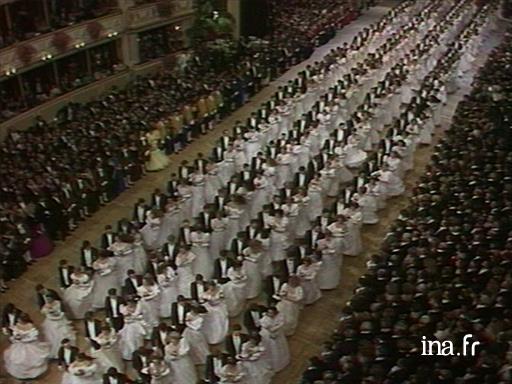
The debutantes ball
Like every year, in Vienna, the debutantes ball gives young people of the high society the opportunity to make their official entrance into the world. We follow Catherina and Barbara preparing for this sumptuous evening. The organizer of the event explains how the male dancers and their partners are chosen. The dance teacher, during rehearsals of the waltz and the bow and the curtsy, explains the importance of learning etiquette in such a society.
Similarly, tango was a revolution to such an extent that the Pope himself asked to see a couple dancing it before he could authorize it, or at least not to have it banned. Rock 'n’ roll, to cite one last example, was a very important way for young people to rebel against the popular culture of their time, and was truly innovative as well.
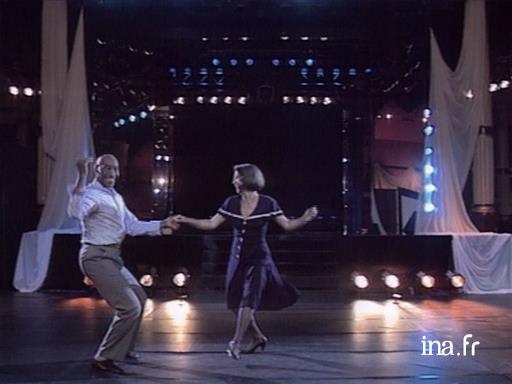
Etoile Palace, demonstration of Lindy hop, Frankie Manning
On the set of "Etoile Palace", Frédéric Mitterrand welcomes the choreographer Frankie Manning, in the presence of the Dancer Cyd Charisse. After having performed a demonstration of lindy hop along with his partner, the dancer talks about the time he was at the Savoy in New York where he danced accompanied by leading jazz orchestras, Duke Ellington, Count Basie. He evokes the cheerful atmosphere and "the world of happy feet" despite the economic crisis at the time.
The great migration
Now that we are clear on the terminology, let us see how these dances, at least some of them, were able to move, evolve, and fuse with others, hence change, during the migration of the peoples that transported them. And for that, let's go back to our King Louis XIV. The new dance masters that he instituted brought back *country dances * (country as in countryside) from England, known as “contradances”, which sounded better to the ears of the Sun King. They were figure dances where all the couples performed the same forms to the same music at the same time. That is how, by developing in France, these dances took off in affluent circles and migrated to French colonies, for example to Saint-Domingue. It was a very productive first major journey.
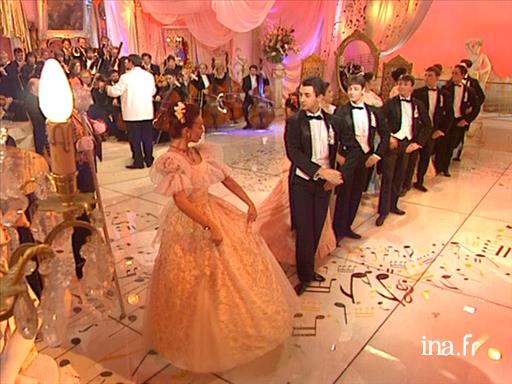
In France, in the middle of the 19th century, these contradances developed under the name of quadrilles. As its name suggests, quadrille can be danced with four people, two couples facing each other. But it is most often danced with four couples, with one couple placed each side of a square. In a large room, there may be a good number of quadrilles being performed at the same time. Even though French quadrille is almost always danced with “figures” and steps made in the same order, this is not so of all quadrilles. Note that, often, there was an "aboyeur" or caller who announced or reminded the dancers of the next figures and steps to be performed. And of course, the dancers regularly changed dancing partners.

Let’s try and remember all that for later: a social dance and a couple dance, both interactive, based on figures and pre-determined steps, conducted live and to music by an aboyeur (*caller * for American *square dances *), where partners were changed on a continuous basis.
In terms of dance steps
To make some headway in this short presentation of social dances, let us go back to the simple principles that will allow us to perhaps track the course of these dances over time: the form of the steps and rhythm of the music used, even though it is not easy to describe dance steps and music with precision using the written word.
With respect to the steps, let’s say that the simplest form is when the foot is placed on the floor for every musical beat, i.e. with two steps (one-two) in 2/4 time: it is also the marching pattern used by all the world’s armies. There is still no rhythm in the sense of a "time variation", but this is the simplest type of beat, which even existed among the Greeks and was known as Pyrrhic; and the dance was called, even then in the 16th century: “branle simple”. In addition, you can easily find three steps (one-two-three) in 3/4 time which is the basic principle of the European Waltz: an odd number of steps allowing you to go from one series starting with the right foot to a series starting with the left foot, thereby allowing you to turn easily, as if you were rocking between the right foot placed in front and the left foot placed behind.
Then we come to, very simply, three steps (one-two-three) in 4/4 time, and we will stop there, because we won’t actually need any more to describe the majority of social dances. In this instance, the rhythm of the succession of steps is represented by two short steps followed by one long step (the Greekanapest); or the other way around: one long step followed by two steps of shorter duration (the Greek dactyl). That's what folk dancers still call the “branle double”
Having explained these details, let's look at a few dances: the polka is always danced to the *anapest * rhythm: we say "quick-quick-slow, quick-quick-slow" in dance classes. The advantage of this rhythm is that it combines two different durations (quick and slow), not to get too complicated, and alternates the right and left foot, allowing the dancer to turn. It can be performed to slow or to fast music. So, it is no surprise that many French people dance the slow, e.g, either with a “military” step in a slow time (one to the right and another to the left), or they use the anapest, the polka step, which is suited to the tempo of the music.
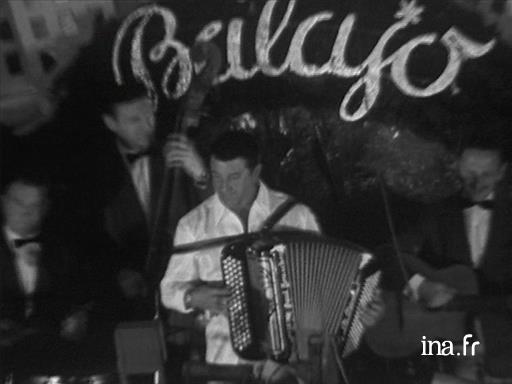
History of the bals musette (dances with accordion music)
On 14th July, the accordion becomes the king of the party. Celebration of a popular instrument that transcended the ages and crossed borders despite its detractors. Alternating musical archives and interviews with accordion lovers and virtuosos, this document traces the career of this portable piano with straps, from the creation of the accordion to its boom in dance halls located on the rue de Lappe, like the Balajo, or in guinguette taverns on the banks of the Marne.
It is not surprising either that this step is also used for the Cuban *bolero *, the Cuban *danzon * and the Mexican danzon, but also for dances we Europeans call rumba, mambo and lambada. The same can be said for salsa, the latest dance to be in vogue.
It only remains for me to say that this succession of three steps, repeated twice can be done in several ways: the best-known is the chassé (whether it be used in choreography, rhythmic dance or martial arts). But these three steps may also take the form of a square (the famous Magic Box of Arthur Murray in the 1950s in the USA), or a trapeze made from the simple deformation of the square, or what is today called the "Latin basis", used in salsa for example.
In terms of dance rhythm
There is still one last very important notion for us to understand with respect to dances with 3 steps in 2/4 time: the rhythm with which the steps are placed on the ground. These three "transfers of bodyweight", as dance professionals say may use the simplest rhythm in the world: the Greek anapest see above (quick-quick-slow). As if by chance, it's what Cubans call "to dance a tiempo", or "*to the tune ''; they also call it "*El baile 1, 2, 3 *”, “bailar en 1” And a part of Cuba dances to this beat. But you can also dance to the reverse rhythm, to the Greek dactyl (slow-quick-quick). Finally, it is possible to dance to a "syncopation": Cubans say: "*dance to the rhythm *", "dancing to 2, 3, 4", or "bailar en 2”, and they call it a dance *a contratiempo *. For us Europeans, it is also a way to dance “off the beat”.
In French, if you arrive late to an appointment, you may say that you had a “contretemps”; you weren't there when you were expected, and you arrive at a time when they weren’t expecting you. It is the same in music: there is an accent on an offbeat, which almost goes unnoticed. And so that you easily understand what follows and to finish off with the technical details, let’s say very simply that "syncopation", another musical concept often used in explanations given by historians, is an extended moment where part of a piece of music is off the beat. So, now when you read that tango is often "syncopated", you will understand what the term means a little better.
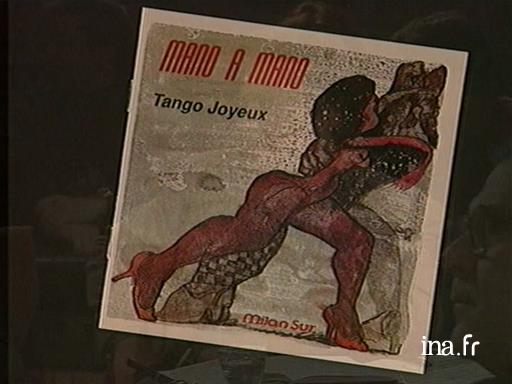
Conclusion
After having danced the quadrilles in the 19th century, which then traveled, which got mixed with other styles and which give rise to an unbroken chain of other variants, we arrive at the present today with “rueda de casino"(Salsa), which is in vogue all over the world. We see that it has the same principles as quadrilles: a social dance which is practiced in a group of couples in a cycle, based on three steps in2/4 time, like the polka in 1843, using the chassé, the square step and the Latin basis; which was a tiempo when danced to 1, 2, 3 and a contratiempo when danced to 2, 3, 4.
But above all, this way of dancing adopts all the same formal features as the quadrilles: once you have started practicing the “basic step”, you just need to know the figures that will be announced by the caller. Everyone also dances with everyone else, making the dance different every time, the speed will be faster, and the joy of dancing will reach its climax.
Historians have closely tracked the geographical course of these dances, but it is only dancers and musicians who can identify the right choreographic and rhythmic features that intrinsically, fundamentally and structurally connect these dances, which could easily, and wrongly be considered separate, or be connected with the wrong dances by mistake.
From simple forms and basic rhythms, they have all become intermingled to give us different styles throughout the ages in every country and in every society, thanks to diverse and new accents, thereby multiplying the sources of enjoyment and exchanges between peoples.
It would not be possible to finish this little travelogue about social dances without briefly mentioning a process that appeared at the beginning of the 20th century and which greatly made it easier for couple dances to cross borders and oceans.
Created in 1909 by a Frenchman, Camille Rhynal, dancing competitions quickly spread worldwide, not only the dancing practices themselves, but also a technique that has become widespread in schools across the globe. A technique which today allows a Japanese or a Frenchman to easily dance the Cuban cha-cha-cha with a Englishman, or an Australian, or a Brazilian...
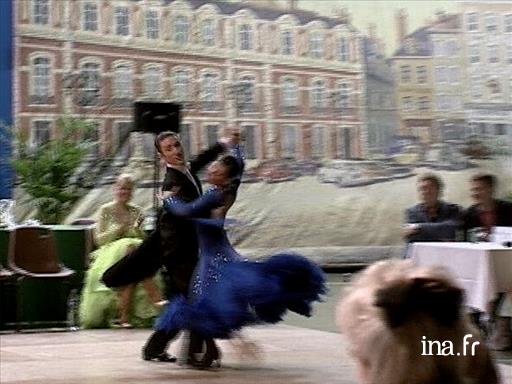
Dancing madly, passionately
Report devoted to dancesport in France, which compares two portraits of fans of this discipline and includes factual images of various competitions.
Some sacrifice everything for this discipline which needs to praticised like figure skating: with tenacity and rigor. In the whole of France, one hundred and thirty clubs are authorized to send candidates to the different competitions. People of all ages are eager to enroll at the clubs concerned.



